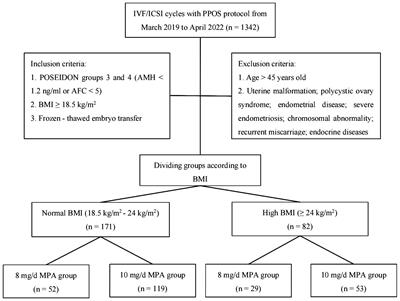Effect of medroxyprogesterone acetate dose in progestin-primed ovarian stimulation on pregnancy outcomes in poor ovarian response patients with different body mass index levels

Background: For the poor ovarian response (POR) population, the relationship between medroxyprogesterone acetate (MPA) dose in progestin-primed ovarian stimulation (PPOS) and clinical outcome is still unclear. This study aims to explore the effect of MPA dose in PPOS on clinical outcomes in POSEIDON group 3 and 4 patients with different body mass index (BMI) levels, hoping to provide clinical doctors with better options for controlled ovarian hyperstimulation (COH) programs. Methods: This is a retrospective analysis of 253 oocyte retrieval cycles of POSEIDON group 3 and 4 patients who underwent PPOS protocol in IVF/ICSI treatment at the Reproductive Medical Center of Renmin Hospital of Wuhan University from March 2019 to April 2022.
The effects of different MPA doses (8 mg/d or 10 mg/d) on pregnancy outcomes were compared in normal BMI (18.5–24 kg/m2) and high BMI (≥24 kg/m2) patients, and multivariate logistic regression analysis was performed to analyze the factors affecting pregnancy outcomes. Results: For normal BMI patients, the 8-mg/d MPA group had a higher embryo implantation rate (33.78% vs. 18.97%, P = 0.012). For high BMI patients, the 10-mg/d MPA group had a higher HCG positive rate (55.00% vs. 25.00%, P = 0.028), clinical pregnancy rate (50.00% vs. 20.00%, P = 0.025), and cumulative pregnancy rate (37.74% vs. 13.79%, P = 0.023) compared with the 8-mg/d MPA group.
There was no significant difference in cumulative live birth rate between the 8-mg/d and 10-mg/d MPA groups in patients with normal or high BMI.
The results of multivariate logistic regression showed a significant correlation between MPA dose and cumulative pregnancy in the high BMI population (OR = 0.199, 95% CI: 0.046~0.861, P = 0.031). Conclusions: For POR patients with high BMI, 10 mg/d of MPA in the PPOS protocol had a higher cumulative pregnancy rate than 8 mg/d of MPA, but it had no significant effect on the cumulative live birth rate.
Read the full article at the original website
References:
